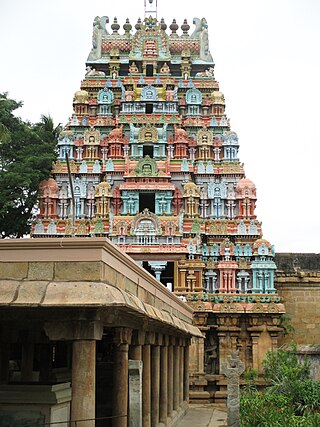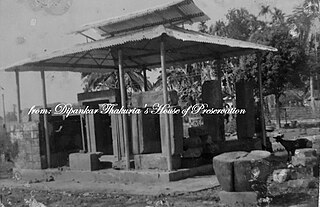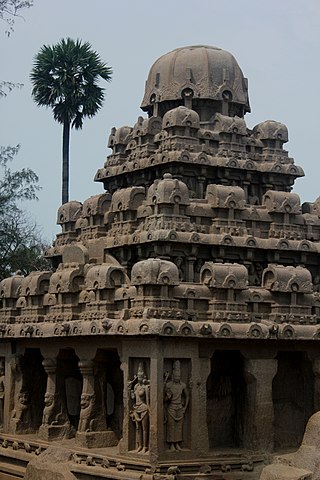
Barakar is a neighbourhood in Asansol, Paschim Bardhaman district in the Indian state of West Bengal. It is governed by the Asansol Municipal Corporation It is situated at the border of the states of Jharkhand and West Bengal. The Grand Trunk Road passes through Barakar. The neighbourhood is located on the banks of the river Barakar.

Jambukeswarar Temple, Thiruvanaikaval is a famous Shiva temple in Tiruchirapalli (Trichy) district, in the state of Tamil Nadu, India. Though it is that Kocengannan, one of the Early Cholas, have built this temple. It is located in the Srirangam island, which has the famous Ranganathaswamy temple.
Konch is a community development block of Gaya district in Bihar, India. Konch(Konch Village/Konch Panchayat/Konch Thana-Police Station) is a typical village market area slowly taking shape of a sub-urban settlement and centre of small business. Konch has very important temple known as Koncheswar Mahadev belonging to the later Gupta period which now has been taken under the protection of Archaeological Survey of India (ASI).
The Ramacharitam is a Sanskrit epic poem written in Arya metre by a Bengali poet named Sandhyakar Nandi during Pala Empire. This work simultaneously narrates the story of the Ramayana and the Pala king Ramapala.It is mainly famous for describing the Varendra rebellion- a very critical event in early mediaeval history of Bengal.

Panchet Dam was the last of the four multi-purpose dams included in the first phase of the Damodar Valley Corporation (DVC). It was constructed across the Damodar River at Panchet in Dhanbad district in the Indian state of Jharkhand, and opened in 1959.

Chand Sadagar was a rich and powerful sea merchant of Champaknagar in Eastern India. This merchant has been claimed by both the Assamese and Bengali people of India to be associated with their respective states and communities. Medieval Bengali poet Bipradas Pipilai mentioned in his "Manasamangal Kāvya" that merchant ship of Chand Sadagar used to proceed to the sea from ancient Champaknagar of Kamarupa after passing through Tribeni, situated at the junction of Saptagram and the confluence of Ganges, Saraswati and Jamuna River of modern-day West Bengal. Narayan Dev in the Assamese scriptures gave an account in his Manasamangal about the merchant ship of the trader Chand Saudagar proceeding to the sea from ancient Champaknagar of Assam passing through Saptagram and Tribeni, the tri-junction of the Ganges, Saraswati and Jamuna River. In the Padmapuran, account of Chand Bania (Sadagar) is specifically mentioned.
Madhukunda is a census village under Bailtora village panchayat of Santuri intermediate panchayat in Purulia district in the Indian state of West Bengal. It is located on the south bank of Damodar River. It is served by the post office at Sunuri.
Para is a village, with a police station, in the Para CD block in the Raghunathpur subdivision of the Purulia district in West Bengal, India.
Sukutesvara Temple located in the old town of bhubaneswar, Odisha,India,serves as purpose for community gathering. The preceding deity in this temple is a Siva- lingam situated at the centre. The temple observes various religious sacraments like Mahasivaratri, Chandipatha and Rudrabhisekha.

The Shore Temple is a complex of temples and shrines that overlooks the shore of the Bay of Bengal. It is located in Mahabalipuram, about 60 kilometres (37 mi) south of Chennai in Tamil Nadu, India.

Arjuna Ratha is a monument from the Pallava Period at Mahabalipuram, on the Coromandel Coast of the Bay of Bengal, in Kancheepuram district of Tamil Nadu, India. Dated to the seventh century, it is an example of early Dravidian architecture and of monolith Indian rock-cut architecture dating from the late 7th century during reign of King Mahendravarman I and his son Narasimhavarman I of the Pallava Kingdom. One of the Pancha Rathas, it is believed to have been completed before the Dharmaraja Ratha, and like that and the Bhima Ratha, the stone temple is a replica of an earlier wooden version which preceded it. It is one of the Group of Monuments at Mahabalipuram designated as a UNESCO World Heritage Site since 1984.
Kudghat is a neighbourhood of South Kolkata in the Indian state of West Bengal. It is a part of greater Tollygunge region. The region is divided into two parts, purba putiary and paschim putiary.

The Bhimeshvara temple is a temple in the town of Nilagunda in the Davangere district of Karnataka state, India.

Baidyapur is a village in Kalna II CD block in Kalna subdivision of Purba Bardhaman district, West Bengal, India.

Jalakandeswarar Temple is a temple dedicated to Lord Shiva which is located in the Vellore Fort, in heart of the Vellore city, in the state of Tamil Nadu, India.
Pakbirra is a village in the Puncha CD block in the Manbazar subdivision of the Purulia district in the state of West Bengal, India.
Deulghata, near Baram in the Arsha in the Purulia Sadar subdivision of the Purulia district of West Bengal, India, has ancient/ medieval temples.
Budhpur is a village in the Manbazar I CD block in the Manbazar subdivision of the Purulia district in the state of West Bengal, India.

Gadarmal Devi temple is a Hindu and Jain temple at Badoh village of Vidisha, Madhya Pradesh.

















